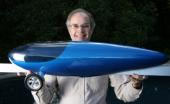From his garage in western Travis County, Jerry Roane is trying to reduce global warming, improve air quality and cut the commute from the Capitol to the airport to about three minutes.
Beneath his home, looking like a beaten-up dinghy, sits the 20- foot-long prototype of Roane's TriTrack automobile, which he built out of a composite material similar to aircraft skin. On paper, at least, the car will run at 180 mph on a fixed guideway, not unlike a superfast monorail. As a "dual-mode" vehicle, it would be able to leave the guideway and travel on regular roads at about 20 mph.
Jerry Roane is competing for a $10 million prize; his entry is a battery-powered car that he says will go from 40 mph to 180 mph in 9.3 seconds on a track — or about 20 mph on city streets.
Roane envisions his car gliding along a 14.5-inch-wide triangular fixed guideway built 17 to 23 feet above the ground. He says it could go from 40 mph to 180 mph in 9.3 seconds.
"It wipes anything on the road today," he said. "It's not as scary as you might think because you're high and it's a smooth ride."
It has yet to move an inch under its own power, though; some Girl Scouts had to push it into position at an event a couple of years ago at the University of Texas.
Roane said the 300-pound, battery-powered TriTrack would have virtually zero emissions and retail for $10,000. He estimates it would cost $170,000 per mile to construct the guideway. "It was $150,000, but the price of steel went up," he said.
For years, Roane has tried to persuade investors and lawmakers to back his idea. Roane has pitched the TriTrack to the Chinese government and to the University of Texas as an express route from the main campus to the J.J. Pickle campus in North Austin.
He has encouraging letters from U.S. Environmental Protection Agency officials, state senators and transportation experts, but so far he's attracted $4,600 from investors while spending about $250,000 of his own money on the prototype.
Now, though, he has two years to try to make it run.
His idea was one of about 30 chosen this summer to participate in the international Automotive X Prize competition, open to inventors of vehicles that can get at least 100 miles per gallon of fuel. The competition is in the early stages, but the winner will get at least $10 million; the finals will be in 2010, said Carrie Fox, a spokeswoman for the California-based X Prize Foundation.
The prize is designed to inspire "superefficient vehicles that help break our addiction to oil and stem the effects of climate change." Inventors will have to show that they could manufacture 10,000 units and make them affordable to the public, according to Neal Anderson, senior director of the Automotive X Prize.
A handful of applications were rejected, Anderson said.
"They screen them to throw out the crazies," Roane said, "and I guess I'm just on the fringe."
Roane, 51, works for a Georgetown company, designing mechanisms that connect one cable to another. He's married with two grown children. An electrical engineer by training, he has at least 18 patents and made his mark with the StakPak, a widely used invention that stacks microchips in a tiny space. His home workshop is littered with machine parts and abuzz with no fewer than six computers.
Roane said he conceived of the TriTrack when he couldn't afford to put gas in his 1968 Firebird during the oil embargo. Decades later, he is faced with having to raise $250,000 to get his prototype road-ready. (This week, he got an estimate for the windshield: $5,000.)
He's confident he can do it.
"This is a race," he said, "and my design is superior in terms of aerodynamics." .

